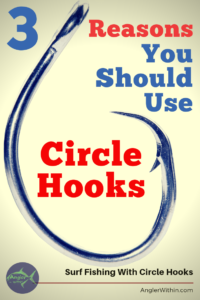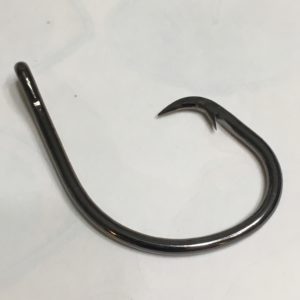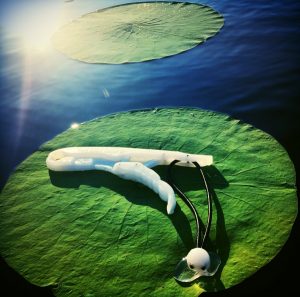If you ever found yourself wondering what exactly is so great about circle hooks, you came to the right place. I’ll lay out the 3 most common reasons why you should be using circle hooks most of the time. And, it doesn’t really matter much what species you are after. This article is primarily intended for surf fishermen, but it’s generally relevant for most saltwater fishing. Enjoy!
A circle hook is made so that the point of the hook is angled back toward the shank to form a sort of “circle” shape, and thus is how it got its name. Shocker, right?! Now, on to the list!

Reasons To Use Circle Hooks
1. Circle Hooks "Set The Hook" Themselves
When using circle hooks, it’s important that you don’t jerk (“set”) the hook when you get a bite. If you do, you will often yank the hook right out of the fish’s mouth. Rather, you should reel down on the fish and allow steady pressure to build. This pressure will set the hook naturally as the hook is pulled from the fish’s mouth.
Alternatively, if your rod is stationary, such as in a rod holder, and the fish makes a run with your bait, the rod and fish will work in tandem to set the hook for you. You can see how this aligns quite well with the style of many surf fishermen. Many of us like to post our rods along the beach in sand spikes and sit down to have a cold drink or wade around searching for bait. This relaxing style of fishing normally makes it impossible to set a hook properly when using traditional “J” hooks. Circle hooks to the rescue!
Due to the nature of a circle hook “setting” itself, that means the timing of the hook-set is far less crucial than normal. Because of this, circle hooks are great for less skilled and, might I say, even for lazy anglers. Beginners, kids and tourists can all benefit greatly from the help of circle hooks.

2. Circle Hooks Catch Fish In The Corner Of The Mouth
The second reason you should be using circle hooks is that they almost always catch fish in the corner of the mouth. With the hook lodged in the corner of a fish’s mouth, your line is kept away from the rough or toothy part of the mouth. This gives you a better opportunity to land the fish before it chews through your mono or flourocarbon leader. In fact, because the leader is generally out of the fish’s mouth, circle hooks allow you to use lighter leader than you might otherwise feel comfortable with for a particular species. Lighter leader often leads to more bites.
3. Circle Hooks Minimize Swallowing Of The Hook
Finally, the biggest reason to use circle hooks is that they greatly reduce the chances of gut-hooking a fish. This is because the design creates a smaller gap between the hook point and the shank of the hook and because the hook point is angled inward. This design offers a much less likelihood that the hook point will grab any part of the fishes throat until after the shank exits the fish’s mouth. As the shank exits, that is when the hook will rock back and penetrate the corner of the fish’s mouth.

I don’t believe there is any debate that “where” you hook a fish is the most determining factor in whether they survive a release. Because we are many times throwing back non-targeted species or fish that are too small, it’s clear that we don’t want to gut-hook fish that are to be released.
The last thing we want is a bunch of belly-up fish floating in the surf around our setup. I won’t go into all the reasons that this is undesired, but I think it’s safe to say that none of us want to needlessly kill fish we don’t intend to keep.
A side benefit to not hooking fish deep in the mouth is that we also lose less tackle over time since we don’t have to regularly free fish with our terminal tackle still in their mouth.
Some Challenges With Circle Hooks
The most important thing to keep in mind when using circle hooks is that you will have to retrain yourself to not jerk the hook when you feel a bite. Sometimes the desire to set the hook can short-circuit your mind even though you know you might yank the hook out of the fish’s mouth. The tendency is to rare back on a fish. This can be difficult to overcome, especially if you also fish for freshwater bass or other species that require a solid hook-set.
Another issue you might run into is over-choking a circle hook. Particularly when fishing with very large baits (think bull red or shark fishing), you have to take care not to fill too much of the hook’s gap with bait. To combat this, either lightly hook the bait or use an over-sized circle hook that can handle the size bait you want.
Always match your hook size to the size of your bait and not to the size of your fish. Filling the hook with too much bait will make a solid hook-set very difficult with circle hooks. I have had strange looks from friends when I show them the size of my shark fishing hooks. They fail to understand that the large hook is needed because of the large bait. It’s not because I’m trying to catch a 2000 pound white shark.
Quick Tips
Here are a few tips to keep in mind when using circle hooks.
- Don’t use offset circle hooks. The offset hook point defeats much of the purpose of using a circle hook in the first place.
- Don’t ever “set” the hook in the traditional sense (jerking). Instead, simply reel down on the fish until the line is tight. That alone will drive the hook home.
- Don’t over-choke a circle hook with too much bait, unless it’s a very soft bait that the hook will easily penetrate. Pieces of peeled shrimp, for example, can be used to cover most of the hook to hide it. However, you should never cover the point of the hook. You need the hook to be able to freely grab the fishes lip as it’s sliding out of its mouth.
- Even with circle hooks, it’s possible to hook a fish in the back of the throat. If there is any doubt, simply cut your line as close to the hook as possible, and let the fish go. The hook should rust out soon enough.
Conclusion
Circle hooks are a great tool for conservation-minded anglers, which hopefully most of us are. Besides that, they are extremely effective for most species and should be the first option we regularly reach for. Happy fishing!



